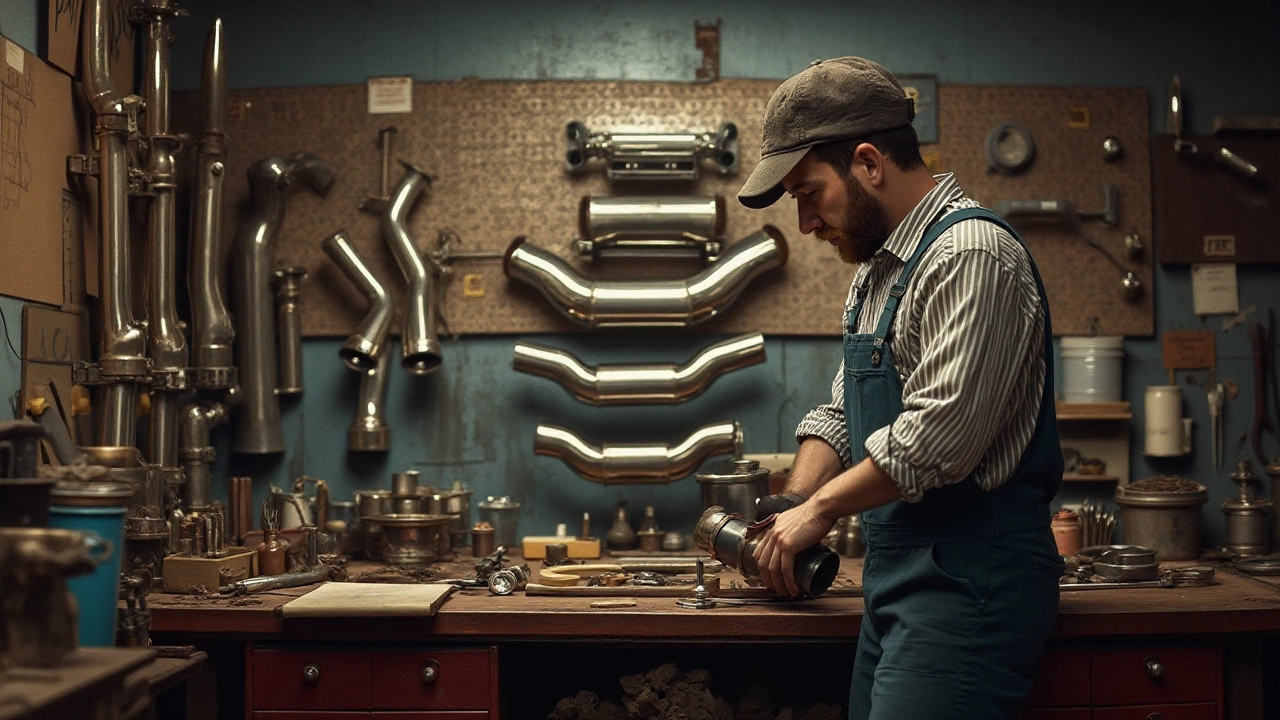When you think about the heartbeat of a vehicle, you might picture the engine, but the exhaust system plays just as crucial a role in keeping the machine running. Whether you're hearing the purr of a high-performance car or the smooth operation of a family sedan, it all comes down to the exhaust system's ability to efficiently redirect gases. But how many of us really know what's happening beneath the hood when it comes to these essential components?
Join us as we unravel the mysteries of exhaust systems, diving into their different types and unique functions. This journey isn't just for gearheads—whether you're a daily commuter, a weekend adventurer, or just curious, understanding exhaust systems can enhance your appreciation of automotive engineering and even inform your next purchase or modification.
- Understanding Exhaust Systems Basics
- Single vs. Dual Exhaust Systems
- Performance Exhaust Systems
- Tips for Choosing and Maintaining Your Exhaust System
Understanding Exhaust Systems Basics
At its core, an exhaust system serves one principal purpose: to channel away gases produced during the internal combustion process while minimizing noise and maximizing efficiency. But as straightforward as this might sound, the intricacies of an exhaust system reveal a fascinating blend of engineering marvels.
Components of an Exhaust System
An exhaust system is typically composed of several key components:
- Exhaust Manifold: Attached directly to the engine, it collects gases from the cylinders and guides them into a single exhaust pipe.
- Catalytic Converter: This component plays a significant role in reducing harmful emissions by converting pollutants into less harmful substances before they leave the vehicle.
- Resonator: Sometimes working in tandem with the muffler, it adjusts the exhaust note by canceling certain sound frequencies.
- Muffler: Responsible for dampening the sound of combustion noises, the muffler is essential for maintaining the vehicle's quiet operation.
- Tailpipe: The point of exit for exhaust gases, usually located at the rear of the vehicle.
The Journey of Exhaust Gases
The efficiency and design of an exhaust system hinge on its ability to manage the flow of exhaust gases. As the engine burns fuel, gases are produced and collected in the manifold. From there, the gases pass through the catalytic converter where a chemical reaction reduces harmful pollutants. Subsequently, the gases are funneled through the resonator and muffler to reduce noise, and finally, ejected through the tailpipe.
Fact Check: Emission Standards and Regulations
With the growing need to tackle environmental concerns, exhaust systems have evolved considerably. The catalytic converter was a revolutionary addition in response to the Clean Air Act. In fact, data from the United States Environmental Protection Agency (EPA) shows that cars manufactured with catalytic converters have significantly reduced the emissions of carbon monoxide, hydrocarbons, and nitrogen oxides.
Keeping Your Exhaust System in Shape
Routine maintenance of an exhaust system goes beyond just reducing noise; it enhances vehicle performance and fuel efficiency. Signs of a faulty system might include strange noises, decreased fuel efficiency, or the unmistakable smell of exhaust fumes.
By understanding the fundamentals of vehicle exhaust systems, drivers can appreciate the importance of this multi-faceted component. Whether aiming for maximum performance or ensuring an environmentally-conscious ride, the exhaust system is an indispensable part of your vehicle's operation.
Single vs. Dual Exhaust Systems
When pondering the exhaust systems of a vehicle, one of the most common distinctions is between single and dual setups. Each has its own set of characteristics and benefits, tailored to different driving needs and performance expectations. But what exactly sets these two apart, and why might one be better suited for your vehicle? Let's delve deeper into the mechanics and advantages of each system.
Single Exhaust Systems
The quintessential exhaust system found in many traditional vehicles is the single exhaust. As the name suggests, this system consists of one set of exhaust components, including a single exhaust pipe. Often favored for their simplicity and cost-effectiveness, single exhaust systems are standard on most economy cars and trucks.
Single exhaust systems typically involve less installation complexity, which can translate to lower maintenance costs. Moreover, they tend to be lighter than dual systems, contributing marginally to fuel efficiency. For single exhaust systems, performance might not be its strongest suit, but it provides adequate exhaust flow for engines not seeking high horsepower gains.
Dual Exhaust Systems
In contrast, dual exhaust systems are designed with two separate exhaust pipes, each offering a pathway for gases to be expelled independently. This design is incredibly popular among performance and sports vehicles, known for enhancing engine efficiency and increasing horsepower. The dual pipes allow for quicker evacuation of exhaust gases, therefore minimizing engine backpressure and optimizing engine performance.
Drivers often choose dual systems for their aesthetic appeal as well. The sight of twin exhaust pipes can signify power and performance, a subtle nod to racing heritage. Yet, it's not just about looks—this system can significantly boost engine efficiency, making a noticeable difference for those craving more spirited driving experiences.
The Choice: Efficiency vs. Performance
The decision between single and dual exhaust largely hinges on your priorities. For daily drivers focused on practicality, the single exhaust provides a no-fuss, reliable solution. Meanwhile, enthusiasts who seek improved vehicle dynamics and a deeper engine rumble may find the dual systems a perfect fit. It's a balance between cost, performance, and the type of vehicle you drive.
Key Takeaways
- Single exhaust systems are typically more affordable and straightforward, making them ideal for everyday vehicles.
- Dual exhaust systems enhance performance and provide a sporty aesthetic, often found in high-performance vehicles.
- Consider your vehicle type, driving habits, and budget when choosing between these systems.
Ultimately, whether you're purring along the highway or roaring around a track, understanding the differences between single and dual exhausts helps in tailoring your vehicle to your unique needs.

Performance Exhaust Systems
In the quest for speed and roaring engine sounds, many automotive enthusiasts turn to performance exhaust systems as their modification of choice. These systems aren't just about making your vehicle sound like a sleek road machine—in fact, they offer a range of tangible benefits, from improved horsepower and torque to greater fuel efficiency and reduced backpressure on the engine.
Key Components of Performance Exhaust Systems
A typical performance exhaust system consists of several key components, each playing a vital role in enhancing the vehicle's performance. These include larger diameter pipes, high-flow catalytic converters, and advanced mufflers.
- Larger Diameter Pipes: By increasing the diameter of the exhaust pipes, these systems facilitate better airflow, which can result in significant power gains.
- High-Flow Catalytic Converters: Designed to increase engine output without sacrificing environmental responsibilities, these converters enhance exhaust flow while still cleaning emissions effectively.
- Performance Mufflers: These are engineered to reduce audio restrictions, allowing for a more aggressive engine sound while optimizing exhaust flow.
Benefits of Performance Exhaust Systems
One of the main aims for installing a performance exhaust system is boosting power. These systems are often tuned to enhance the engine's output by minimizing restrictions known as backpressure. As a result, the engine can breathe easier, meaning it can produce more power and torque.
Moreover, vehicle exhaust optimization through these systems can induce a more combustible fuel mixture, enhancing fuel efficiency. Though the mileage gains may not be game-changing, every drop of fuel saved counts.
Additionally, a performance system offers a unique sound profile. It can give a vehicle a distinctive growl that lingers long after the car has accelerated away, a symphony many car lovers covet.
To put things into perspective, a well-designed performance exhaust system can improve engine efficiency by as much as 10%, offering a noticeable boost not only in power but also in overall vehicle dynamics. Below is a table illustrating typical improvements with performance exhaust systems:
| Aspect | Improvement |
|---|---|
| Horsepower | 5-10% |
| Torque | 5-10% |
| Fuel Efficiency | 2-5% increase |
Considerations Before Installing
Before rushing to install a performance exhaust system, consider your vehicle's compatibility. What works for one might not work for another. Research thoroughly, check compatibility with your vehicle model, and understand your local noise regulations to avoid any legal complications. Also, consider professional installation to ensure optimal performance and safety.
Performance exhaust systems are a fantastic way to upscale your vehicle's performance and sound profile, offering a satisfying blend of power, efficiency, and that satisfying roar. Whether you’re enhancing an aging cruiser or maximizing a modern hatchback, these modifications represent a strategic upgrade, lending personality and enhanced capability to your ride. It's about driving pleasure, after all, and these systems deliver just that.
Tips for Choosing and Maintaining Your Exhaust System
Selecting the right exhaust system for your vehicle isn't just about sound or aesthetics—it's about enhancing performance and efficiency. To make an informed decision, start by considering your vehicle type, driving habits, and intended use. Are you looking for a basic upgrade for your daily commute, or something that will boost performance on the track? Understanding your needs will guide you to the correct choice.
Considerations When Choosing an Exhaust System
Vehicle Compatibility
First and foremost, ensure the exhaust system you're eyeing is compatible with your vehicle model. Manufacturers design systems for specific makes, models, and years, so it's essential to double-check this compatibility to avoid fitment issues. An incompatible system can lead to decreased performance and potentially damage your vehicle.
Material Matters
The material of the exhaust system plays a significant role in its longevity and performance. Stainless steel systems are popular for their durability and corrosion resistance, particularly in regions with harsh weather conditions. However, if you're looking for something more budget-friendly, aluminized steel offers decent protection at a lower price but may not last as long.
Sound and Performance
Another consideration is the sound profile you desire. Some drivers prefer the quiet hum of a refined exhaust, while others crave the aggressive growl of high-performance systems. Keep in mind, that the sound is often a byproduct of system design and can hint at performance improvements, such as increased horsepower or torque.
Maintaining Your Exhaust System
Regular Inspections
One of the best ways to maintain your exhaust system is through regular inspections. Look for signs of rust, damage, or leaks. Catching these early can prevent more serious issues down the road. A small hole or weak spot in the exhaust can often be patched if caught early enough.
Cleaning
Cleaning isn't just for your car's exterior. Regularly washing your exhaust system can prevent corrosion, especially if your vehicle frequently encounters road salt or other harsh elements. Use dedicated cleaners and avoid abrasive tools that might damage the surface.
Professional Servicing
Sometimes, the best maintenance is done by a professional. Have your exhaust system serviced by a trusted mechanic to ensure optimal performance and catch any tricky issues that aren't clearly visible. This can involve everything from a simple visual inspection to replacing worn components.
Ultimately, your exhaust system is a key player in your vehicle's overall performance and longevity. By choosing wisely and maintaining diligently, you ensure a smoother ride and a longer life for your car. Whether you're navigating city traffic or racing down the highway, a well-maintained exhaust system will serve you well on your journey.






